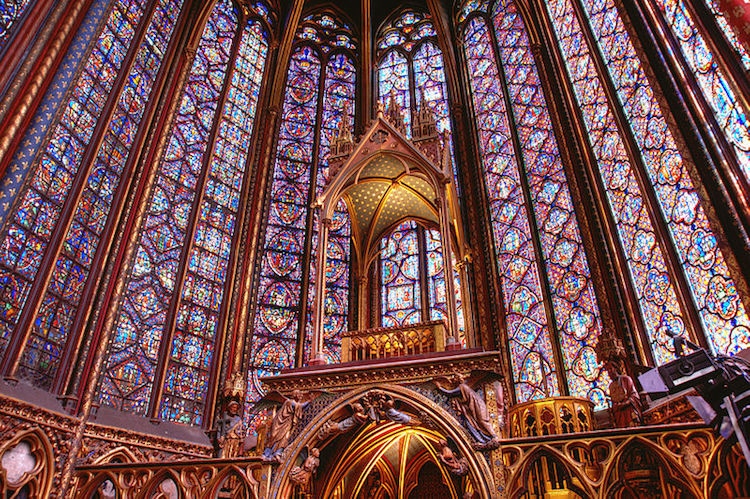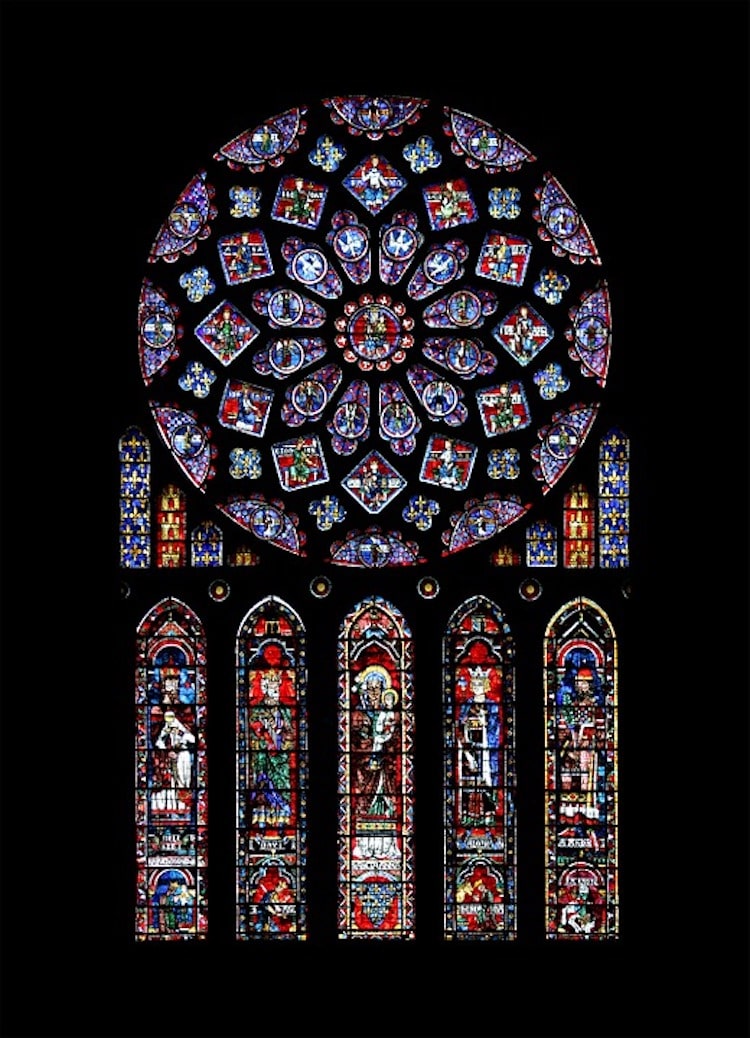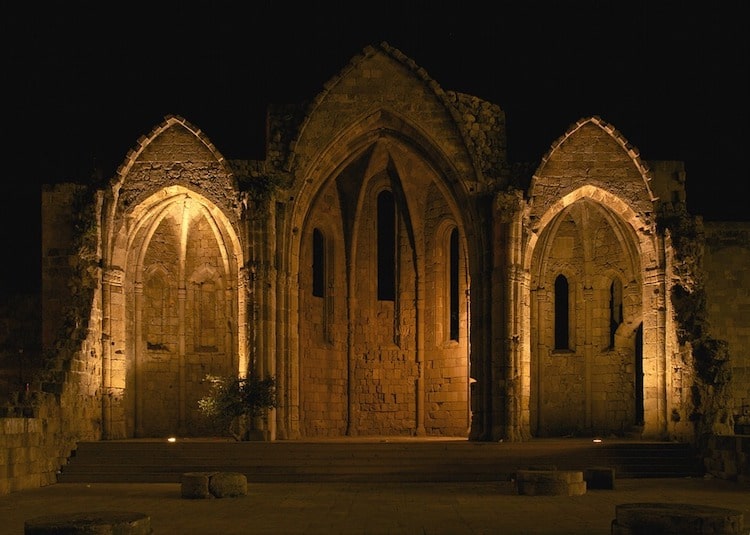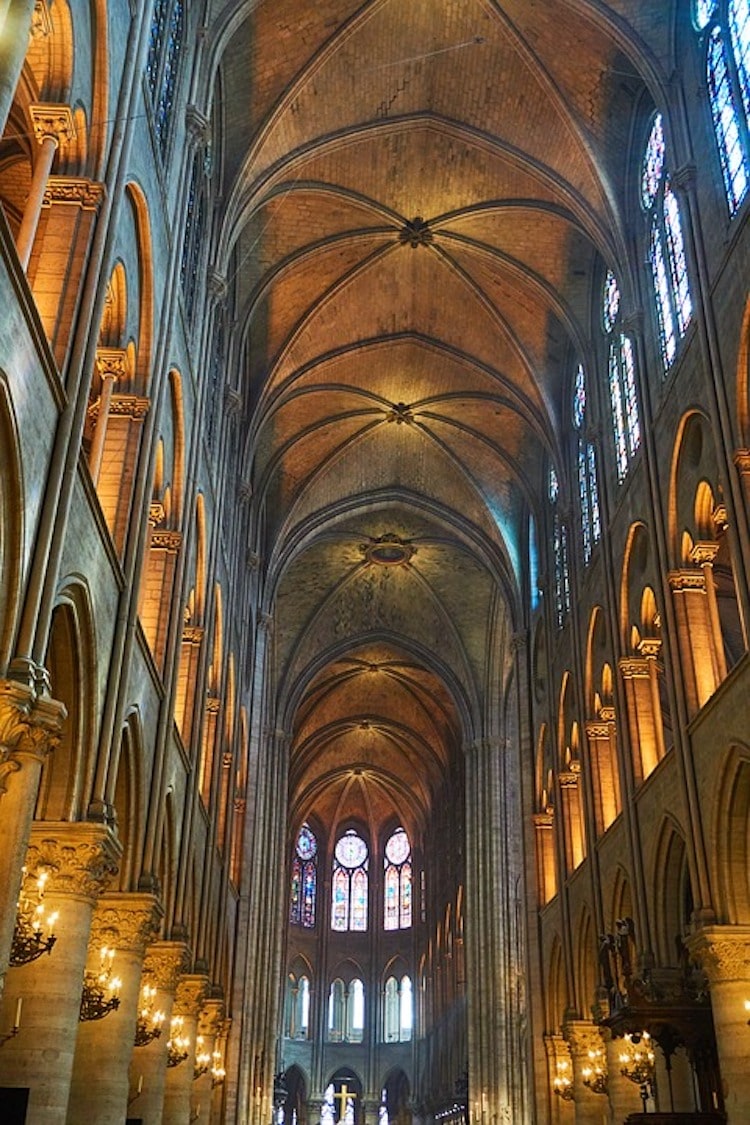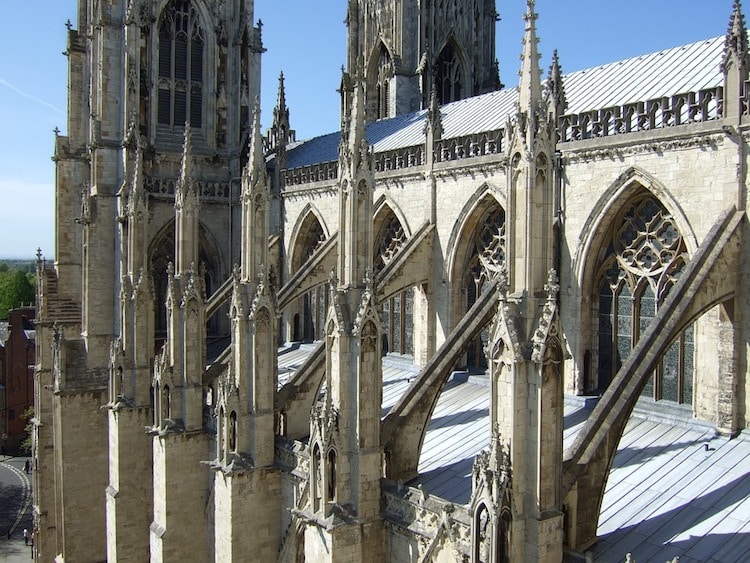- Stained Glass Windows: Medieval Art Form and Religious Meditation
- Key Takeaways: Stained Glass
- Definition of Stained Glass
- History of Stained Glass Windows
- How to Make Stained Glass
- Gothic Window Shapes
- Medieval Cathedrals
- Medieval Meaning
- Cistercian Stained Glass (Grisailles)
- Gothic Revival and Beyond
- What We Can Learn From the Exquisite History and Ornate Aesthetic of Gothic Architecture
- Classic Elements
- Large Stained Glass Windows
- Pointed Arches
- Ribbed Vaults
- Flying Buttresses
- Ornate Decoration
Stained Glass Windows: Medieval Art Form and Religious Meditation
Print Collector / Getty Images
- M.A., Anthropology, University of Iowa
- B.Ed., Illinois State University
Stained glass is transparent colored glass formed into decorative mosaics and set into windows, primarily in churches. During the art form’s heyday, between the 12th and 17th centuries CE, stained glass depicted religious tales from the Judeo-Christian Bible or secular stories, such as Chaucer’s Canterbury tales. Some of them also featured geometric patterns in bands or abstract images often based on nature.
Making Medieval stained glass windows for Gothic architecture was dangerous work performed by guild craftsmen who combined alchemy, nano-science, and theology. One purpose of stained glass is to serve as a source of meditation, drawing the viewer into a contemplative state.
Key Takeaways: Stained Glass
- Stained glass windows combine different colors of glass in a panel to make an image.
- The earliest examples of stained glass were done for the early Christian church in the 2nd–3rd centuries CE, although none of those survived.
- The art was inspired by Roman mosaics and illuminated manuscripts.
- The heyday of Medieval religious stained glass took place between the 12th and 17th centuries.
- Abbot Suger, who lived in the 12th century and reveled in blue colors representing the «divine gloom,» is considered the father of stained glass windows.
Definition of Stained Glass
Stained glass is made of silica sand (silicon dioxide) that is super-heated until it is molten. Colors are added to the molten glass by tiny (nano-sized) amounts of minerals—gold, copper, and silver were among the earliest coloring additives for stained glass windows. Later methods involved painting enamel (glass-based paint) onto sheets of glass and then firing the painted glass in a kiln.
Stained glass windows are a deliberately dynamic art. Set into panels on exterior walls, the different colors of glass react to the sun by glowing brightly. Then, colored light spills out from the frames and onto the floor and other interior objects in shimmering, dappled pools that shift with the sun. Those characteristics attracted the artists of the Medieval period.
History of Stained Glass Windows
Glass-making was invented in Egypt about 3000 BCE—basically, glass is super-heated sand. Interest in making glass in different colors dates to about the same period. Blue in particular was a prized color in Bronze Age Mediterranean trade in ingot glass.
Putting shaped panes of differently colored glass into a framed window was first used in early Christian churches during the second or third century CE—no examples exist but there are mentions in historical documents. The art may well have been an outgrowth of Roman mosaics, designed floors in elite Roman houses that were made up of squares pieces of rock of different colors. Glass fragments were used to make wall mosaics, such as the famous mosaic at Pompeii of Alexander the Great, which was made primarily of glass fragments. There are early Christian mosaics dated to the 4th century BCE in several places throughout the Mediterranean region.
By the 7th century, stained glass was used in churches throughout Europe. Stained glass also owes a great deal to the rich tradition of illuminated manuscripts, handmade books of Christian scripture or practices, made in Western Europe between about 500–1600 CE, and often decorated in richly colored inks and gold leaf. Some of the 13th century stained glass works were copies of illuminated fables.
How to Make Stained Glass
The process of making glass is described in a few existing 12th-century texts, and modern scholars and restorers have been using those methods to replicate the process since the early 19th century.
To make a stained glass window, the artist makes a full-sized sketch or «cartoon» of the image. The glass is prepared by combining sand and potash and firing it at temperatures between 2,500–3,000°F. While still molten, the artist adds a small amount of one or more metallic oxides. Glass is naturally green, and to get clear glass, you need an additive. Some of the main mixtures were:
- Clear: manganese
- Green or blue-green: copper
- Deep blue: cobalt
- Wine-red or violet: gold
- Pale yellow to deep orange or gold: silver nitrate (called silver stain)
- Grassy green: combination of cobalt and silver stain
The stained glass is then poured into flat sheets and allowed to cool. Once cooled, the artisan lays the pieces onto the cartoon and cracks the glass in rough approximations of the shape using a hot iron. The rough edges are refined (called «grozing») by using an iron tool to chip away the excess glass until the precise shape for the composition is produced.
Next, the edges of each of the panes are covered with «cames,» strips of lead with an H-shaped cross-section; and the cames are soldered together into a panel. Once the panel is complete, the artist inserts putty between the glass and cames to aid in waterproofing. The process can take from a few weeks to many months, depending on the complexity.
Gothic Window Shapes
The most common window shapes in Gothic architecture are tall, spear-shaped «lancet» windows and circular «rose» windows. Rose or wheel windows are created in a circular pattern with panels that radiate outwards. The largest rose window is at Notre Dame Cathedral in Paris, a massive panel measuring 43 ft in diameter with 84 glass panes that radiate outward from a central medallion.
Medieval Cathedrals
The heyday of stained glass occurred in the European Middle Ages, when guilds of craftsmen produced stained glass windows for churches, monasteries, and elite households. The blossoming of the art in medieval churches is attributed to the efforts of Abbot Suger (ca. 1081–1151), a French abbot at Saint-Denis, now best known as the place where French kings were buried.
About 1137, Abbot Suger began to rebuild the church at Saint-Denis–it had been first built in the 8th century and was sorely in need of reconstruction. His earliest panel was a large wheel or rose window, made in 1137, in the choir (eastern part of the church where the singers stand, sometimes called the chancel). The St. Denis glass is remarkable for its use of blue, a deep sapphire that was paid for by a generous donor. Five windows dated to the 12th century remain, although most of the glass has been replaced.
The diaphanous sapphire blue of Abbot Suger was used in various elements of the scenes, but most significantly, it was used in backgrounds. Prior to the abbot’s innovation, backgrounds were clear, white, or a rainbow of colors. Art historian Meredith Lillich comments that for Medieval clergy, blue was next to black in the color palette, and deep blue contrasts God the «father of lights» as super-light with the rest of us in «divine gloom,» eternal darkness and eternal ignorance.
Medieval Meaning
Gothic cathedrals were transformed into a vision of heaven, a place of retreat from the noise of the city. The portrayed images were mostly of certain New Testament parables, especially the prodigal son and the good Samaritan, and of events in the life of Moses or Jesus. One common theme was the «Jesse Tree,» a genealogical form that connected Jesus as descended from the Old Testament King David.
Abbot Suger began to incorporate stained glass windows because he thought they created a «heavenly light» representing the presence of God. The attraction to the lightness in a church called for taller ceilings and larger windows: it has been argued that architects attempting to put larger windows into cathedral walls in part invented the flying buttress for that purpose. Certainly moving heavy architectural support to the exterior of the buildings opened up cathedral walls to larger window space.
Cistercian Stained Glass (Grisailles)
In the 12th century, the same stained glass images made by the same workers could be found in churches, as well as monastic and secular buildings. By the 13th century, however, the most luxurious were restricted to cathedrals.
The divide between monasteries and cathedrals was primarily of topics and style of stained glass, and that arose because of a theological dispute. Bernard of Clairvaux (known as St. Bernard, ca. 1090–1153) was a French abbot who founded the Cistercian order, a monastic offshoot of the Benedictines that was particularly critical of luxurious representations of holy images in monasteries. (Bernard is also known as the supporter of the Knights Templar, the fighting force of the Crusades.)
In his 1125 «Apologia ad Guillelmum Sancti Theoderici Abbatem» (Apology to William of St. Thierry), Bernard attacked artistic luxury, saying that what may be «excusable» in a cathedral is not appropriate to a monastery, whether cloister or church. He probably wasn’t referring particularly to stained glass: the art form didn’t become popular until after 1137. Nonetheless, the Cistercians believed that using color in images of religious figures was heretical—and Cistercian stained glass was always clear or gray («grisaille»). Cistercian windows are complex and interesting even without the color.
Gothic Revival and Beyond
The heyday of the medieval period stained glass ended about 1600, and after that it became a minor decorative or pictorial accent in architecture, with some exceptions. Beginning in the early 19th century, the Gothic Revival brought old stained glass to the attention of private collectors and museums, who sought restorers. Many small parish churches obtained medieval glasses—for example, between 1804–1811, the cathedral of Lichfield, England, obtained a vast collection of early 16th century panels from the Cistercian convent of Herkenrode.
In 1839, the Passion window of the church of St. Germain l’Auxerrois in Paris was created, a meticulously researched and executed modern window incorporating medieval style. Other artists followed, developing what they considered a rebirth of a cherished art form, and sometimes incorporating fragments of old windows as part of the principle of harmony practiced by Gothic revivalists.
Through the latter part of the 19th century, artists continued to follow a penchant for earlier medieval styles and subjects. With the art deco movement at the turn of the 20th century, artists such as Jacques Grüber were unleashed, creating masterpieces of secular glasses, a practice that still continues today.
What We Can Learn From the Exquisite History and Ornate Aesthetic of Gothic Architecture
Classic Elements
While the Gothic style can vary according to location, age, and type of building, it is often characterized by 5 key architectural elements: large stained glass windows, pointed arches, ribbed vaults, flying buttresses, and ornate decoration.
Large Stained Glass Windows
While stained glass windows are found in many places of worship, they are particularly prevalent in Gothic cathedrals. Featuring meticulously cut colored glass, these kaleidoscopic windows—which are typically either tall and arched ‘lancet’ windows or round ‘rose’ windows—are larger than those found in other types of churches. This allowed them to let in more dazzling light.
Interior of Sainte-Chapelle, Paris (Photo: Jean-Christophe BENOIST (Own work) [CC BY 3.0], via Wikimedia Commons)
Pointed Arches
A primary feature of many religious structures, ample archways can be found in most Gothic churches and cathedrals. Rather than the wide, rounded arches characteristic of Romanesque buildings, however, architects working in the Gothic style adapted the tall, thin pointed arches found in Islamic architecture.
This silhouette accentuated each cathedral’s height, symbolically pointed toward the sky, and accommodated similarly-shaped vaulting.
Ribbed Vaults
In order to incorporate higher ceilings and taller windows into their designs, Gothic architects utilized a new method of structural support called ribbed vaulting. Ribbed vaulting involves the use of intersecting barrel vaults—arches placed parallel to one another in order to support a rounded roof.
In addition to showcasing a more decorative aesthetic than traditional barrel vaults, these criss-crossed constructions offer increased support for the sky-high buildings.
Flying Buttresses
On top of these advanced vaulting techniques, Gothic architects employed another unique method of structural support: flying buttresses. These projecting stone structures reinforced the buildings by redistributing the weight of the heavy roof to a lower, more solid level.
Flying buttresses ensured the cathedrals’ integrity so that architects did not need to sacrifice the thin walls and large windows distinctive of the Gothic style.
Ornate Decoration
A final feature found in Gothic architecture is the presence of ornate decorative elements. These include embellished colonnades and colonettes, sculptural moldings, statues of saints and historical figures, pinnacles and spires, and gargoyles, grotesque figures that double as water spouts.
:max_bytes(150000):strip_icc()/Chartres_Cathedral_Christ_Virgin-00dea391ad4f43aab86f1e80a3b9cc88.jpg)
:max_bytes(150000):strip_icc()/Saint-Denis_Basilica_Paris-caad4b2be6cd4e6a99b22b23098ddf9e.jpg)
:max_bytes(150000):strip_icc()/mosaic_pompeii_alexander_detail-5958d9c13df78c4eb66d797c.jpg)
:max_bytes(150000):strip_icc()/Illustrated_Manuscript_13thC-dbf90d123c204f01ad31f8f582d29fbb.jpg)
:max_bytes(150000):strip_icc()/stained_glass_artist-35062e8f4f96457b91effe4b03e2bf27.jpg)
:max_bytes(150000):strip_icc()/Notre_Dame_Stained_Glass_Rose_Window-1e4162ed35d344fa90c052f3fe54d1cd.jpg)
:max_bytes(150000):strip_icc()/Saint_Denis_Cathedral-b8fa9e0cb76e4c5cb0a64801d47cdebd.jpg)
:max_bytes(150000):strip_icc()/Chartres_Cathedral_Jesse_Tree-0b593eb25b82484c9960fb3181840cee.jpg)
:max_bytes(150000):strip_icc()/Eberbach_Abbey-9cd9bf57cecb4c79aa8928e0f668cafb.jpg)
:max_bytes(150000):strip_icc()/St._Germain_lAuxerrois_Stained_Glass-2dd8d34a869d47a3ab115239b5ed8be5.jpg)
